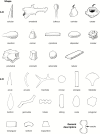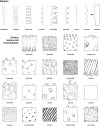International Code for Phytolith Nomenclature (ICPN) 2.0
- PMID: 31334810
- PMCID: PMC6758648
- DOI: 10.1093/aob/mcz064
International Code for Phytolith Nomenclature (ICPN) 2.0
Abstract
Background: Opal phytoliths (microscopic silica bodies produced in and between the cells of many plants) are a very resilient, often preserved type of plant microfossil. With the exponentially growing number of phytolith studies, standardization of phytolith morphotype names and description is essential. As a first effort in standardization, the International Code for Phytolith Nomenclature 1.0 was published by the ICPN Working Group in Annals of Botany in 2005. A decade of use of the code has prompted the need to revise, update, expand and improve it.
Scope: ICPN 2.0 formulates the principles recommended for naming and describing phytolith morphotypes. According to these principles, it presents the revised names, diagnosis, images and drawings of the morphotypes that were included in ICPN 1.0, plus three others. These 19 morphotypes are those most commonly encountered in phytolith assemblages from modern and fossil soils, sediments and archaeological deposits. An illustrated glossary of common terms for description is also provided.
Keywords: Phytoliths; code; morphotype; nomenclature; taxonomy.
© The Author(s) 2019. Published by Oxford University Press on behalf of the Annals of Botany Company. All rights reserved. For permissions, please e-mail: journals.permissions@oup.com.
Figures





References
-
- Albert RM, Weiner S. 2001. Study of phytoliths in prehistoric ash layers using a quantitative approach. In: Meunier JD, Colin F, eds. Phytoliths: applications in Earth sciences and human history. Lisse: Balkema, 251–266.
-
- Albert RM, Bamford MK, Cabanes D. 2009. Palaeoecological significance of palms at Olduvai Gorge, Tanzania, based on phytolith remains. Quaternary International 193: 41–48.
-
- Albert RM, Ruiz JA, Sans A. 2016. PhytCore ODB: a new tool to improve efficiency in the management and exchange of information on phytoliths. Journal of Archaeological Science 68: 98–105.
-
- Albuquerque ESB de, Alvarenga Braga JM, Cardoso Vieira R. 2013. Morphological characterisation of silica phytoliths in Neotropical Marantaceae leaves. Plant Systematics and Evolution 299: 1659–1670.
-
- Alexandre A, Meunier JD, Lézine AM, Vincens A, Schwartz D. 1997. Phytoliths: indicators of grasslands dynamics during the late Holocene in intertropical Africa. Palaeogeography, Palaeoclimatology, Palaeoecology 136: 213–229.
Publication types
MeSH terms
Substances
LinkOut - more resources
Full Text Sources
Research Materials

